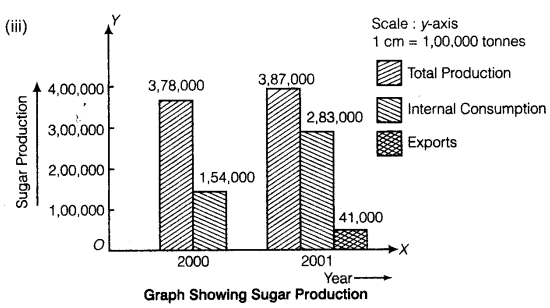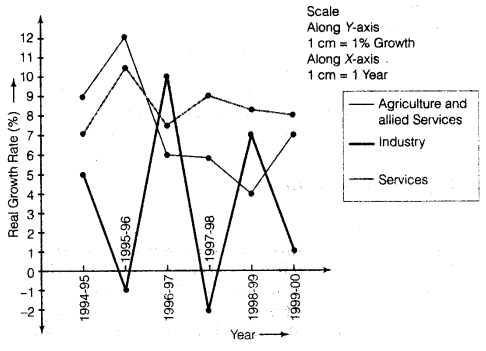Statistics for Economics Class 11 NCERT Solutions Chapter 4 Presentation of Data
Answer: the following questions, 1 to 10, choosing the correct answer.
Question 1.
Bar diagram is a
(a) one-dimensional diagram
(b) two-dimensional diagram
(c) diagram with no dimension
(d) None of these
Answer:
(a) Bar diagrams are one-dimensional diagrams. Though these are represented on a plane of two axis in form of rectangular bars, the width is of no consequence and only the length depicts the frequency.
Question 2.
Data represented through a histogram can help in finding graphically the
(a) mean
(b) mode
(c) median
(d) All of these
Answer:
(b) Histogram gives value of mode of the frequency distribution graphically through the highest rectangle.
Question 3.
Ogives can be helpful in locating graphically the
(a) mode
(b) mean
(c) median
(d) None of these
Answer:
(c) Intersection point of the less than and more than ogives gives the median.
Question 4.
Data represented through arithmetic line graph help in understanding
(a) long term trend
(b) cyclicity in data
(c) seasonality in data
(d) All of the above
Answer:
(a) Arithmetic line graph helps in understanding the trend, periodicity, etc in a long term time series data.
Question 5.
Width of bars in a bar diagram need not be equal. (True/False)
Answer:
False
Bar diagram comprises a group of equispaced and equiwidth rectangular bars for each class or category of data.
Question 6.
Width of rectangles in a histogram should essentially be equal. (True/False)
Answer:
False
If the class intervals are of equal width, the area of the rectangles are proportional to their respective frequencies and width of rectangles will be equal. However, sometimes it is convenient or necessary to use varying width of class intervals and hence unequal width of rectangles.
Question 7.
Histogram can only be formed with continuous classification of data. (True/False)
Answer:
True
A histogram is never drawn for a discrete variable/data. If the classes are not continuous they are first converted into continuous classes.
Question 8.
Histogram and column diagram are the same method of presentation of data. (True/False)
Answer:
False
Histogram is a two dimensional diagram drawn for continuous data and the rectangles do not have spaces in between while column diagram is one dimensional with space in between every column (bar).
Question 9.
Mode of a frequency distribution can be known graphically with the help of histogram. (True/False)
Answer:
True
Histogram gives value of mode of the frequency distribution graphically through the highest rectangle.
Question 10.
Median of a frequency distribution cannot be known from the ogives. (True/False)
Answer:
False
Intersection-point of the less than and more than ogives gives the median.
Question 11.
What kind of diagrams are more effective in representing the following?
(a) Monthly rainfall in a year
(b) Composition of the population of Delhi by religion
(c) Components of cost in a factory
Answer:
(a) The monthly rainfall in a year can be best represented by a bar diagram as only one variable i.e., monthly rainfall is to be presented diagrammatically. The rainfall is plotted on Y-axis in the corresponding month that is plotted on the X-axis.
(b) Composition of the population of Delhi by religion can be represented by a component bar diagram. A component bar diagram shows the bar and its sub-divisions into two or more components. Thus, the total population can be sub divided in terms of religion and presented through a component bar diagram.
(c) Different components of cost in a factory can most effectively be depicted through a pie chart. The circle represents the total cost and various components of costs are shown by different portions of the circle drawn according to percentage of total cost each component covers.
Question 12.
Suppose you want to emphasise the increase in the share of urban non-workers and lower level of urbanisation in India as shown in Example 4.2. How would you do it in the tabular form?
Answer:
Share of urban workers and non workers in India
| Location | |||
| Sex | Worker in urban (in crore) | Non-worker in urban (in crore) | Total |
| Male | 50 | 70 | 120 |
| Femal | 25 | 50 | 75 |
| Total | 75 | 120 | 195 |
Question 13.
How does the procedure of drawing a histogram differ when class intervals are unequal in comparison to equal class intervals in a frequency table?
Answer:
A histogram is a set of rectangles with bases as the intervals between class boundaries (along X-axis) and with areas proportional to the class frequency. If the class intervals are of equal width, the area of the rectangles are proportional to their respective frequencies.
However, sometimes it is convenient or at times necessary, to use varying width of class intervals. For graphical representation of such data, height for area of a rectangle is the quotient of height i.e., frequency and base i.e., width of the class interval. When intervals are equal, all rectangles have the same base and area can conveniently be represented by the frequency of the interval.
But, when bases vary in their width, the heights of rectangles are to be adjusted to yield comparable measurements by dividing class frequency by width of the class interval instead of absolute frequency. This gives us the frequency density for the purpose of comparison.
Thus
Question 14.
The Indian Sugar Mills Association reported that, ‘sugar production during the first fortnight of December, 2001 was about 3,87,000 tonnes, as against 3,78,000 tonnes during the same fortnight last year (2000). The off-take of sugar from factories during the first fortnight of December, 2001 was 2,83,000 tonnes for internal consumption and 41,000 tonnes for exports as against 1,54,000 tonnes for internal consumption and nil for exports during the same fortnight last season.’
(i) Present the data in tabular form.
(ii) Suppose you were to present these data in diagrammatic form which of the diagrams would you use and why?
(iii) Present these data diagrammatically.
Answer:
(i) Data in tabular form.
Sugar Production in India
| Total Production (tonnes) | Off-take for Internal Consumption (tonnes) | Off-take for Exports (tonnes) | |
| December 2000 | 378000 | 154000 | — |
| December 2001 | 387000 | 283000 | 41000 |
(ii) The data can effectively be presented diagrammatically using the multiple bar diagram. This is because multiple bar diagrams are used for comparing two or more sets of data for different years or classes, etc.
Question 15.
The following table shows the estimated sectoral real growth rates (percentage change over the previous year) in GDP at factor cost.
Represent the data as multiple time-series graphs.
Answer:











